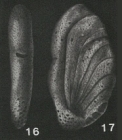Foraminifera taxon details
Ammoastuta Cushman & Brönnimann, 1948
415042 (urn:lsid:marinespecies.org:taxname:415042)
accepted
Genus
Ammoastuta salsa Cushman & Brönnimann, 1948 (type by original designation)
- Species Ammoastuta aegyptiaca Luger, 1985 †
- Species Ammoastuta caudriae Petters, 1954 †
- Species Ammoastuta curfsi Hofker, 1966 †
- Species Ammoastuta inepta (Cushman & McCulloch, 1939)
- Species Ammoastuta megacribrostomoides Luger, 1985 †
- Species Ammoastuta nigeriana Petters, 1979 †
- Species Ammoastuta sakhalinica Voloshinova, 1961 †
- Species Ammoastuta salsa Cushman & Brönnimann, 1948
- Species Ammoastuta salsa Cushman & Brönnimann Em. Bursch, 1952 accepted as Ammoastuta salsa Cushman & Brönnimann, 1948
marine, brackish, fresh, terrestrial
feminine
Cushman, J.A.; Brönnimann, P. (1948). Some new genera and species of foraminifera from brackish water of Trinidad. <em>Contribution to Laboratory for Foraminiferal Research.</em> 24(1): 15-21., available online at https://cushmanfoundation.org/PersonifyEbusiness/Portals/0/pdf/pubarchive/cclfr/24cclfr1.pdf
page(s): p. 17 [details] Available for editors [request]
[request]
page(s): p. 17 [details] Available for editors
Hayward, B.W.; Le Coze, F.; Vachard, D.; Gross, O. (2024). World Foraminifera Database. Ammoastuta Cushman & Brönnimann, 1948. Accessed at: https://www.marinespecies.org/foraminifera/aphia.php?p=taxdetails&id=415042 on 2024-04-19
Date
action
by
2009-09-23 14:01:30Z
created
db_admin
original description
Cushman, J.A.; Brönnimann, P. (1948). Some new genera and species of foraminifera from brackish water of Trinidad. <em>Contribution to Laboratory for Foraminiferal Research.</em> 24(1): 15-21., available online at https://cushmanfoundation.org/PersonifyEbusiness/Portals/0/pdf/pubarchive/cclfr/24cclfr1.pdf
page(s): p. 17 [details] Available for editors [request]
[request]
page(s): p. 17 [details] Available for editors
From editor or global species database
Diagnosis Test compressed, ovate to flabelliform proloculus followed by second chamber growing in opposite direction, in an incipient tight coil, then uniserial, with a few small rectilinear chambers that increase in length as added, finally followed by elongate adult chambers with a slightly curved axis that each occupy about one-half the test periphery, the bulging basal part of the chambers enclosing the corresponding part of earlier adult chambers; wall agglutinated on an organic base, surface smoothly finished; primary aperture areal, a curved transverse slit near the midpoint of the apertural face, secondary cribrate openings on the bulging proximal end of the adult chambers. U. Cretaceous (Turonian to Santonian): Nigeria; S. Chad; U. Eocene or Oligocene: Colombia; Holocene: USA: Louisiana; Caribbean mangrove swamps in Trinidad, West Indies; Panama; Ecuador, Brazil. (Loeblich & Tappan, 1987, Foraminiferal Genera and Their Classification) [details]
